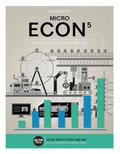
ECON MICRO
5th Edition
ISBN: 9781337000536
Author: William A. McEachern
Publisher: Cengage Learning
expand_more
expand_more
format_list_bulleted
Question
Chapter 19, Problem 1.4P
To determine
The reasons for specialization in international trade
Concept Introduction:
International specialization: It is a method of production where an economy emphasizes on the production of a product or service to gain greater degrees of efficiency and welfare.
Expert Solution & Answer
Want to see the full answer?
Check out a sample textbook solution
Students have asked these similar questions
not use ai please
answer both question in the picture below swteo by step and give right answer please and explain
not use ai please
Knowledge Booster
Similar questions
- A linear programming computer package is needed. As part of the settlement for a class action lawsuit, Hoxworth Corporation must provide sufficient cash to make the following annual payments (in thousands of dollars). 6 Year 1 23. 4 Payment 160 185 210 255 285 430 The annual payments must be made at the beginning of each year. The judge will approve an amount that, along with earnings on its investment, will cover the annual payments. Investment of the funds will be limited to savings (at 4% annually) and government securities, at prices and rates currently quoted in The Wall Street Journal. Hoxworth wants to develop a plan for making the annual payments by investing in the following securities (par value = $1,000). Funds not invested in these securities will be placed in savings. Security Current Price 1 $1,055 Rate (%) Years to Maturity 6.750 3 2 $1,000 5.125 Assume that interest is paid annually. The plan will be submitted to the judge and, if approved, Hoxworth will be required to…arrow_forwardPut the sections of Cornell notes in the order of completion.arrow_forwardagree or disagree with the post Hi Class! Egyptian dates are much sweeter! Due largely to their climate and geography, Egypt, Saudi Arabia, Algeria, and Iran produce more dates than either the US or Canada. Dates grow best in hot dry climates with long dry growing seasons, which these nations naturally offer. They also produce a lot of dates because of their extensive agricultural, infrastructure, and centuries-old date-growing expertise. Conversely, the U.S., there aren't many places in Canada and California that are suitable for date farming, only a select few, like the Coachella Valley, in California can produce dates on a large scale. Although California produces some dates, it is not as much as countries like Saudi Arabia and Egypt. Depending only on U.S., because of increased labor and production costs, dates grown in this way may have a limited supply and raise prices. We can obtain a greater supply of dates at competitive prices while maintaining consistent quality by…arrow_forward
- In 1932 babe Ruth made $75,000. How much is that in todays dollars please give the right answer step by steparrow_forwardEvaluate machine XYZ when MARR is 12% per year. Pertinent data are as follows: Machine XYZ Investment cost Expected life Market (salvage) value Annual revenue Annual expenses $10,000 5 years $1,000 $8,000 $4,000 How much is the excess of the cash flow using the Annual Worth Method? Blank 1 Calculate the External Rate of Return. Blank 2 Compute the payback period of the investment. Blank 3 Would you recommend this investment? Explain briefly. Blank 4arrow_forwardPlease make sure to answer each step and show work. Thank you!arrow_forward
arrow_back_ios
SEE MORE QUESTIONS
arrow_forward_ios
Recommended textbooks for you


 Principles of Economics 2eEconomicsISBN:9781947172364Author:Steven A. Greenlaw; David ShapiroPublisher:OpenStax
Principles of Economics 2eEconomicsISBN:9781947172364Author:Steven A. Greenlaw; David ShapiroPublisher:OpenStax Principles of MicroeconomicsEconomicsISBN:9781305156050Author:N. Gregory MankiwPublisher:Cengage Learning
Principles of MicroeconomicsEconomicsISBN:9781305156050Author:N. Gregory MankiwPublisher:Cengage Learning Essentials of Economics (MindTap Course List)EconomicsISBN:9781337091992Author:N. Gregory MankiwPublisher:Cengage Learning
Essentials of Economics (MindTap Course List)EconomicsISBN:9781337091992Author:N. Gregory MankiwPublisher:Cengage Learning Principles of Macroeconomics (MindTap Course List)EconomicsISBN:9781285165912Author:N. Gregory MankiwPublisher:Cengage Learning
Principles of Macroeconomics (MindTap Course List)EconomicsISBN:9781285165912Author:N. Gregory MankiwPublisher:Cengage Learning



Principles of Economics 2e
Economics
ISBN:9781947172364
Author:Steven A. Greenlaw; David Shapiro
Publisher:OpenStax

Principles of Microeconomics
Economics
ISBN:9781305156050
Author:N. Gregory Mankiw
Publisher:Cengage Learning

Essentials of Economics (MindTap Course List)
Economics
ISBN:9781337091992
Author:N. Gregory Mankiw
Publisher:Cengage Learning

Principles of Macroeconomics (MindTap Course List)
Economics
ISBN:9781285165912
Author:N. Gregory Mankiw
Publisher:Cengage Learning